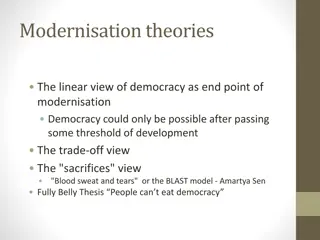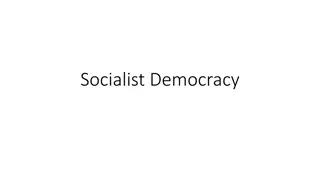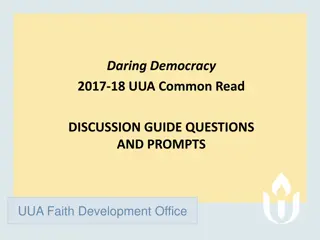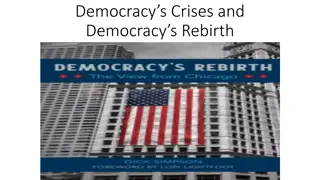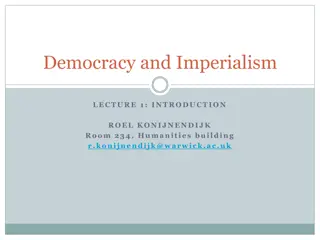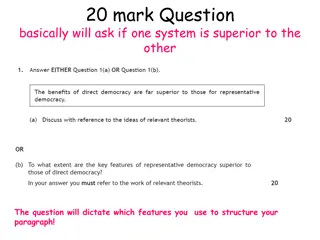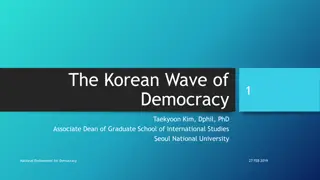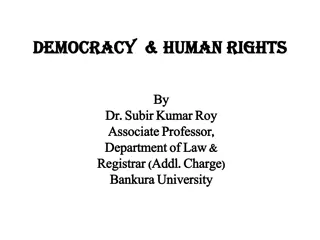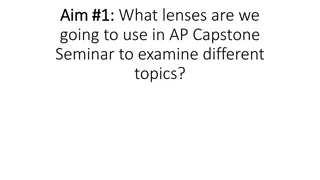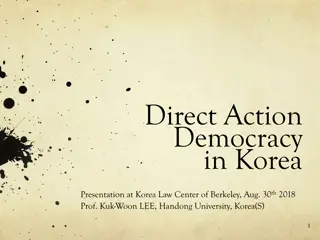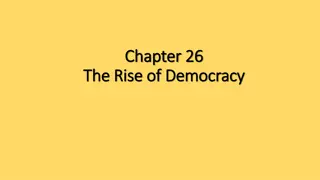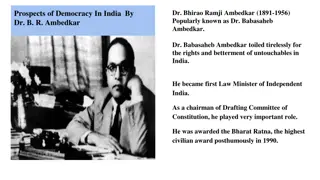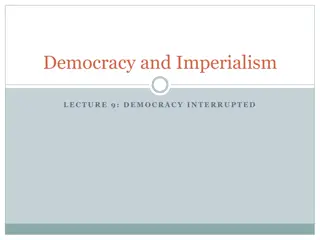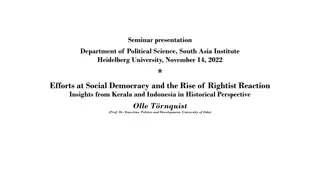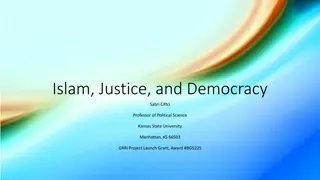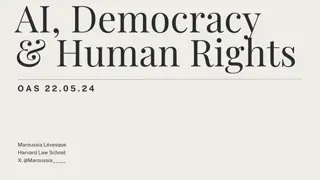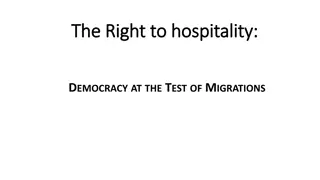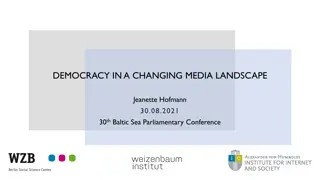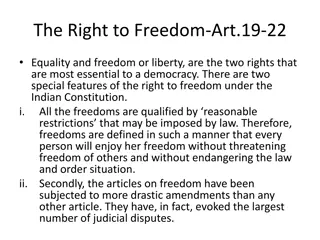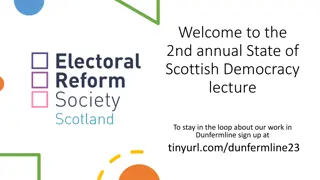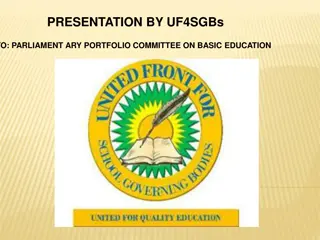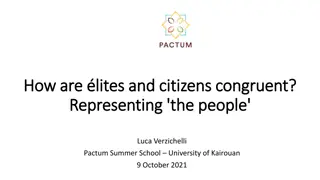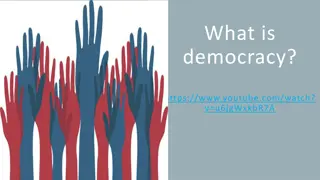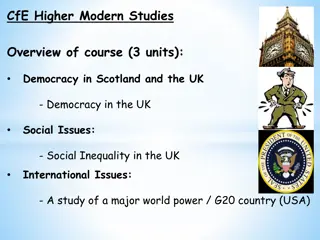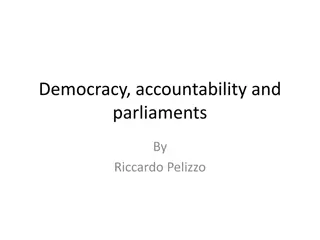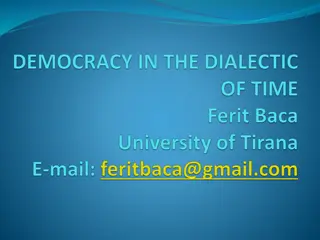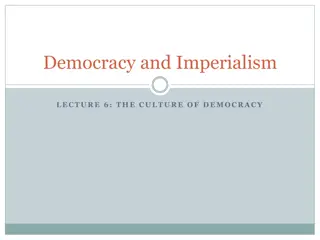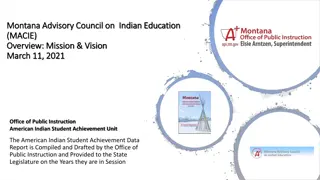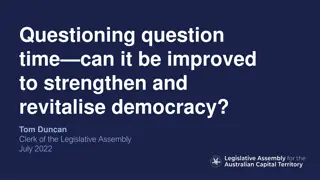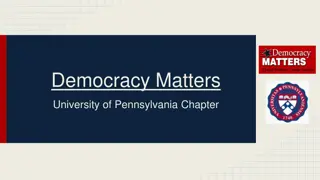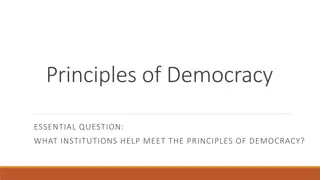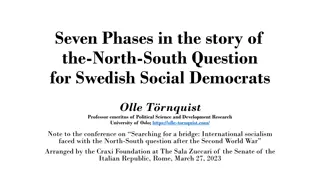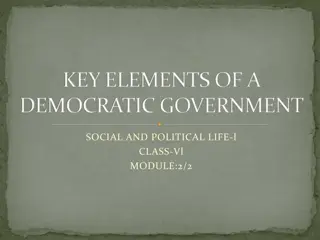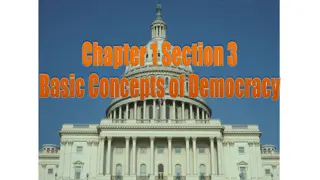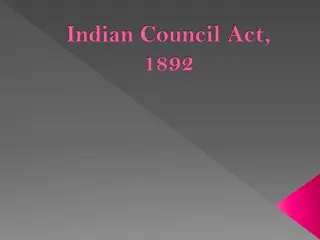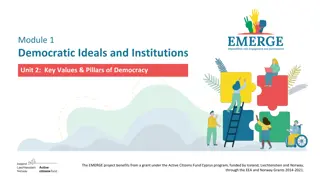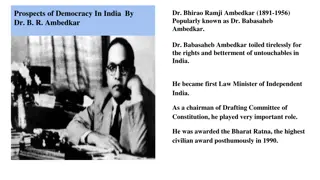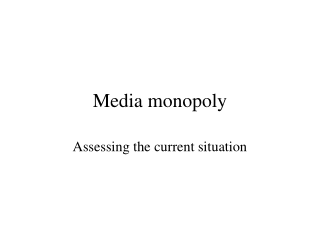Challenges Faced by Indian Democracy: Solutions and Way Forward
Democracy in India faces various challenges including casteism, communalism, regionalism, poverty, terrorism, corruption, illiteracy, and more. These challenges must be addressed for the effective functioning of democracy. The society's division based on caste, religious tensions, and socio-economic inequalities pose significant hurdles. Implementing solutions such as promoting unity, education, and equality can help overcome these obstacles and strengthen the democratic system in India.
Download Presentation

Please find below an Image/Link to download the presentation.
The content on the website is provided AS IS for your information and personal use only. It may not be sold, licensed, or shared on other websites without obtaining consent from the author. Download presentation by click this link. If you encounter any issues during the download, it is possible that the publisher has removed the file from their server.
E N D
Presentation Transcript
Democracy in India: Challenges and Solutions By Indu Sinha Assistant professor, Graduate school college for women Jamshedpur,Jharkhand UNIT:V, 1STSEMESTER
Democracy Democracy is a type of Government by the people, of the people and for the people- Abraham Lincoln People are enjoying the right to decide the affairs directly or indirectly. The Indian Constitution has provided the parliamentary system of democracy based on the three organs of the government i.e. Legislature, Executive and Judiciary. Each organ is free in their field but constitution adopted the policy of checks and balances for proper functioning of the government.
Challenges Challenges are difficulties which are of greater importance and should be overcome. We can go to higher levels only by overcoming the challenges. After adopting the LPG(liberalization, privatization, globalization) model, Indian democracy is also facing some challenges. For the smooth functioning of the government, these challenges must be sorted out.
Challenges to Indian democracy: Casteism Communalism Regionalism Poverty and Unemployment Terrorism and Violence Criminalization of Politics Corruption and Nepotism Environmental Degradation Illiteracy Population Explosion Socio-Economic inequality
Casteism Indian society is primarily divided on the basis of cast. Caste system is based on four fold division of society (varna order) Brahmin (scholars), Kshatriya(warrior), Vaishya(Business class) and Sudra (Labourers) Untouchability is banned under the constitution but is still prevailing in the society. State politics in India is a hot bed of Political casteism. Party tickets during elections are distributed keeping in view the caste factor. Caste dominated cabinet e.g Mysore-Lingayats, Maharastra- Marathas Mandalisation of Indian politics paid way for the decline of Congress dominance. Reservation policy has become a vote bank for political parties. Caste scenario led to the rise of dalits among Hindus, Muslims and Christians.
Communalism India is a land of diverse religions and cultures- Hinduism, Islam, Sikhism, Christianity, Buddhism etc. Hindus constitute majority and other religions constitute the minority. Creation of separate electorate for Muslims during British rule is said to be a policy of divide and rule Religious frenzy led to the partition of Indian subcontinent into Pakistan with Muslims and India with Hindus. After independence religion continued to be an important factor in Indian Politics. Political parties Jan Sangh, Muslim League, Akali dal and RSS are religion based parties. Universities like Banaras Hindu University, Aligarh Muslim University are having religious sanctions. Communal riots are now common feature in India.
Regionalism Refers to sub-nationalism demanding preference for a region as against the country as a whole. More effective and narrow than lingualism. The sucessionest movements and demand for independent political entities have been the painful expression of regionalism. Section of Mizos and the DMK party demand separation from the main land. Similarly, the demand for full-fledged statehood in North Eastern India ( AP , Nagaland, Tripora and Manipur) are manifestation of regionalism. Hill development councils are the offshoots of regionalism.
Poverty and Unemployment The British rule in India has largely been responsible for the poverty in India. In India 22% of its population is living below official Bellow Poverty Limit. After independence, Indian government launched number of poverty alleviation programmes: Integrated Rural Development Scheme (1978) Jawahar Rozgar Yojna (1989) Employment Assurance Schemme (1993) Sampoorna Grameen Rozgar Yojna (2001) National Rural Employment Gurantee, Act (2006)
Terrorism and Violence The terrorist use technique of spreading terror by killing innocent people to achieve their goals. States like Jammu & Kashmir, Haryana, Punjab, Delhi, North Eastern states, Maharastra and Tamil Nadu are most prone targets of terrorist violence. State sponsored terrorism like third degree torture against suspects, murder and rapes in police custody, illegal detention, excessive use of force during agitations are common forms found in India. Naxalite movement, Militant movement and Religious fanaticism are the common isolationist forces working in India. Assassination of Indra Gandhi in 1984, Rajiv Gandhi in 1991 and Beant Singh, CM of Punjab are the examples of political violence. Elections are increasingly becoming very violent mostly on communal basis, caste basis and inter-party violence.
Criminalization of Politics Indian democracy has been hijacked by the criminal elements. Crime-politics nexus is a serious risk to national security. There is not a single state where politicians are not involved in huge scandals. Even sting MLA s and MP s have grave charges of corruption, rape, instigating violence etc. 16th Lok Sabha has highest number (34%) of MP s with criminal cases. (Source: ADR) One way of breaking this nexus is to address the basic issue of electoral reforms. Political parties should also have code of conduct to be fallowed.
Corruption and Nepotism Corruption is possible at any level. Someone at a key position or at low position may fall prey to corruption. Corruption left unpunished at the top, thrives and acquires the attribute of facility, design and pursuit. It neutralises values and norms, defeats order and understanding, destroys amity and obstructs the operation of law. Nepotism is patronage bestowed in consideration of family relations in disregard to merit. Nepotism is connected with power and authority and originates when it is misused.
Environmental Degradation Environmental degradation occurred from man s assertion that he is the master of the earth and its resources are exclusively for him. The global warming has become a major environmental issue which is producing Greenhouse effect Fuel combustion in various forms is biggest man-made source of carbon-dioxide and nitrous oxide. The basic reason for degradation is the industrial revolution. India ranks fifth in the list of world polluters with the United States of America at the top of the list. In India it occurred due to widespread Deforestation, building large dams, Mining etc.
Illiteracy The major problem of Indian political system is the widespread illiteracy. In India, 48 percent people are illiterate; 50 percent children dropout at the primary stage. Factors responsible for illiteracy are problems of poverty, Geographical isolation, Linguistic diversity, Malnutrition, Overpopulation, Social and ethnic tensions, Inadequate educational infrastructure, etc. Lockheed Report says that female literacy scenario is worst in India, particularly among SC, ST , the females are denied education facility. A report on the Primary Education in India points out that in the rural areas, for every 100 girls in class1, only 40 survive upto class V , only 18 reach class VII, 9 reach class IX and only one is able to make it to class XII.
Population explosion Broadly speaking there are only three possible causes of an increase in the population of a country: (a) high birth rate (b) relatively lower death rate, and (c) immigration In India economic development has failed to maintain pace with the population growth. The population has crossed 100 crore mark in 2000 A.D present statistics is 1.311 billion ( Source: Census of India) The rapid growth in population has aggravated other problems like inadequate availability of food, rise of unemployment, low standard of living, etc. The Government had taken several mission mode steps including population stabilization, gender and demographic balance etc.
Socio-Economic Inequality The constitution of India is based upon socio-economic justice. It is socio political document. Under the Constitution of India, every citizen is equal before the law and is entitled to equal protection of the law within the territory of India. Article 15(4) empowers the government to make special provision for the advancement of any socially and educationally backward class of citizens or for SC s and ST s There are various types of inequalities in Indian society as there is plurality of cultures. Exploitation of children as child abuse, trafficking, etc are commonly found among the backward classes. Schedule Caste and Schedule Tribe people are usually doing odd jobs like prostitution and manual scavenging.
Solutions People should be aware about their rights guaranteed under the constitution. Each organ of the government should be accountable. Political parties should be accountable for their election related expenses. The Government should give preference for the development of the remote areas and the conflict zones like North Eastern states and Jammu & Kashmir. The right of the minorities should be protected. The reformative measures for the rehabilitation of naxalists and millitants should be initiated.



